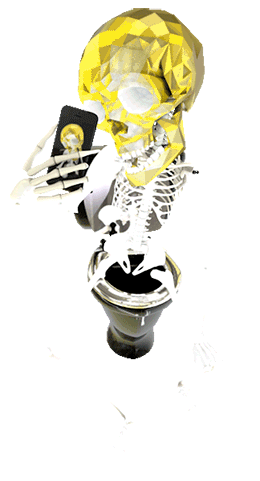technology
Time to put the O back in Cuntry

Haberman wanted grocery stores to embrace the 12-digit Universal Product Code—better known as the barcode—to create a standardized system for tracking inventory and speeding checkout. He took his fellow execs to a nice dinner. Then, as was the fashion at the time, they went to see Deep Throat. […]
Without the barcode, FedEx couldn’t guarantee overnight delivery. […] Nearly all babies born today in U.S. hospitals get barcode bracelets as soon as they’re swaddled.
art { Cy Twombly, Untitled, 1968 }
‘If in the first act you have hung a pistol on the wall, then in the following one it should be fired. Otherwise don’t put it there.’ –Anton Chekhov
I no longer look at somebody’s CV to determine if we will interview them or not,” declares Teri Morse, who oversees the recruitment of 30,000 people each year at Xerox Services. Instead, her team analyses personal data to determine the fate of job candidates.
She is not alone. “Big data” and complex algorithms are increasingly taking decisions out of the hands of individual interviewers – a trend that has far-reaching consequences for job seekers and recruiters alike. […]
Employees who are members of one or two social networks were found to stay in their job for longer than those who belonged to four or more social networks (Xerox recruitment drives at gaming conventions were subsequently cancelled). Some findings, however, were much more fundamental: prior work experience in a similar role was not found to be a predictor of success.
“It actually opens up doors for people who would never have gotten to interview based on their CV,” says Ms Morse.
It was Me, L Boogs and Yan Yan, YG, Lucky ride down Rosecrans
Commercial drone flights are set to become a widespread reality in the United States, starting next year, under a 2012 law passed by Congress. […]
Military drones have slammed into homes, farms, runways, highways, waterways and, in one case, an Air Force C-130 Hercules transport plane in midair. […]
Several military drones have simply disappeared while at cruising altitudes, never to be seen again. […]
The documents describe a multitude of costly mistakes by remote-control pilots. A $3.8 million Predator carrying a Hellfire missile cratered near Kandahar in January 2010 because the pilot did not realize she had been flying the aircraft upside-down.
As one that had been studied in his death
It is an object of the present invention to provide a practical and affordable device to disperse cremated remains in a special and honorary manner. […]
At an appointed time, the remains are loaded into one or more mortar launchers mounted on the back of a mobile unit, be it a vehicle or other mobile device, and propelled into the sky. When an appropriate altitude is reached, the explosive device is activated and explodes, causing the ashen remains to disintegrate and cover an expansive area with the ash. The loved ones may feel that the spirit of the departed lingers in that area, allowing surviving family and friends to enjoy the comfort of having a part of the loved one physically and figuratively all around them.
{ Wallace N. Brown via Improbable }
‘It is impossible to suffer without making someone pay for it; every complaint already contains revenge.’ —Nietzsche
New study finds Internet not responsible for dying newspapers
Gentzkow notes that the first fallacy is that online advertising revenues are naturally lower than print revenues, so traditional media must adopt a less profitable business model that cannot support paying real reporters. The second is that the web has made the advertising market more competitive, which has driven down rates and, in turn, revenues. The third misconception is that the Internet is responsible for the demise of the newspaper industry.
‘Or, si l’habit ne fait pas le moine, l’habitation fait l’habitant.’ —Alexandre Dumas, fils
In shopping malls, for instance, a firm called Euclid Analytics collects, in its own words, “the presence of the device, its signal strength, its manufacturer (Apple, Samsung, etc.), and a unique identifier known as its Media Access Control (MAC) address.” In London last year, one start-up installed a dozen recycling bins that sniffed MAC addresses from passers-by, effectively tracking people through the area via their phones. Such companies go to great lengths to explain that such information in not personally identifiable—except that repeated studies have shown that this data can indeed be used to infer a great deal about your life.
At the core of such tracking is the MAC address, a unique identification number tied to each device. Devices looking for a Wi-Fi network send out their MAC address to identify themselves. Wireless routers receive the signals—and addresses—even if a connection is never made. Companies like Euclid or its peer Turnstyle Solutions use the data to track footfall in stores, how people move about in shops, how long they linger in certain sections, and how often they return. Store-owners use the information to target shoppers with offers (paywall) or to move high-value items to highly-trafficked parts of the shop, among other things. […]
Apple’s solution, as discovered by a Swiss programmer, is for iOS 8, the new operating system for iPhones which will be out later this year, to generate a random MAC addresses while scanning for networks. That means that companies and agencies that collect such information will not necessarily know when the same device (i.e., person) visits a store twice, or that the same device pops up in stores across the country or the world, suggesting a much-travelled owner.
1 less problem without ya
Though industrially important, 3D printing has turned out to be nowhere near as disruptive as once imagined, and certainly nothing like the PC. […]
The one 3D-printing method to make it successfully into the home so far is “fused deposition modelling” (FDM). In this, the object of desire is constructed, layer by layer, by melting a plastic filament and coiling it into the shape required. As ingenious as FDM is, the “maker movement” is still waiting for its equivalent of the Commodore 64, a capable and affordable machine that helped pitchfork the hobbyist computer movement into widespread consumer acceptance.
Another type of 3D printing, stereolithography, may yet challenge FDM for personal use. Stereolithography deposits thin layers of polymer which are then cured by laser or ultraviolet light. The technique was patented by Charles Hull in 1986, several years before Scott Crump patented FDM. These two inventors went on to found the two leading firms in the business today, 3D Systems and Stratasys. 3D Systems is bent on reducing the cost of stereolithography, so it, too, can appeal to the masses. […]
At least three things prevent personal 3D printing from going mainstream. The first is that the printing process takes hours or even days to complete. If the desired object is a standard part, it is invariably quicker and cheaper to buy the equivalent injection moulding off the shelf.
The second problem is poor quality. The printing materials, mostly polymers such as acrylonitrile butadiene styrene or polylactic acid, lack the mechanical strength needed for making parts sturdy enough to do a useful job. ABS has good impact resistance but it does not bear loads particularly well. PLA’s virtue is that it degrades naturally into lactic acid, a harmless substance. This makes it useful for printing things like hearing aids, teeth braces and medical implants. Neither plastic, though, is suitable for fabricating replacement parts for a lawnmower, a child’s bicycle or a vintage car, in which mechanical strength and rigidity are crucial. In all likelihood, things made for handy tasks around the home will need to be reasonably strong, and also require more precise dimensions than today’s desktop 3D printers can manage. Thus, the third problem—namely, the abysmal resolution of products made by popular 3D printers. Tolerances of at least two or three thousandths of an inch (a tenth of a millimetre or so), not tenths of an inch, are the minimum required for home-made parts that are to be interchangeable, or have a fit and finish necessary to work reliably with one another. Personal 3D printers will remain playthings until they can achieve such standards.
One answer is to print with metals, or even carbon composites or ceramics, instead of plastics. Many 3D printers used in industry do precisely that. Industrial metal printers, for instance, use a process known as selective laser sintering (SLS), in which a powerful laser is fired into a bed of powdered metal to sinter particles together, layer upon layer, into the required outline, until the object is built up. A newer version of SLS, which uses an electron beam in a vacuum chamber, allows the sintering to be done at much lower temperatures.
Unfortunately, SLS printers cost anything up to $125,000. It is going to take quite a while before the cost of printing metals (two orders of magnitude more expensive than printing plastics) becomes cheap enough for home use.
‘Funeral by funeral, theory advances.’ –Paul Samuelson
Over the past year, I’ve spent a great deal of time trolling a variety of underground stores that sell “dumps” — street slang for stolen credit card data that buyers can use to counterfeit new cards and go shopping in big-box stores for high-dollar merchandise that can be resold quickly for cash. By way of explaining this bizarro world, this post takes the reader on a tour of a rather exclusive and professional dumps shop that caters to professional thieves, high-volume buyers and organized crime gangs. […]
Like many other dumps shops, McDumpals recently began requiring potential new customers to pay a deposit (~$100) via Bitcoin before being allowed to view the goods for sale. Also typical of most card shops, this store’s home page features the latest news about new batches of stolen cards that have just been added, as well as price reductions on older batches of cards that are less reliable as instruments of fraud. […]
People often ask if I worry about shopping online. These days, I worry more about shopping in main street stores. McDumpals is just one dumps shop, and it adds many new bases each week. There are dozens of card shops just like this one in the underground (some more exclusive than others), all selling bases [batches of cards] from unique, compromised merchants.
Intrance on back. Most open on the lay-days.
In a paper published in the journal Science, physicists reported that they were able to reliably teleport information between two quantum bits separated by three meters, or about 10 feet.
Quantum teleportation is not the “Star Trek”-style movement of people or things; rather, it involves transferring so-called quantum information — in this case what is known as the spin state of an electron — from one place to another without moving the physical matter to which the information is attached.
‘Will you ever forget bis goggle eye?’ –James Joyce

The highest European Union court decided on Tuesday that Google must, in some cases, grant users a so-called right to be forgotten that includes the removal of links to embarrassing legal records.
related { Research in India suggests Google search results can influence an election | Biased search rankings alter the voting preferences of undecided voters }
images { 1 | 2. Gregory Reid }
‘God created war so that Americans would learn geography.’ —Mark Twain

Behind the scenes of the NY redesign
That includes using Github instead of SVN for version control, Vagrant environments, Puppet deployment, using requireJS so five different versions of jQuery don’t get loaded, proper build/test frameworks, command-line tools for generating sprites, the use of LESS with a huge set of mixins, a custom grid framework, etc.
THIS IS WHO I AM NOW, OKAY?

Why were old scientific instruments put together with an apparent wish to make them beautiful, and not just coldly functional?
First, there is obviously a selection effect at work here of the kind that all historians and curators are familiar with. What tends to get preserved is not a representative cross-section of what is around at any time, but rather, what is deemed to be worth preserving. […]
Second, there were of course no specialized scientific-instrument manufacturers in the early modern period. When investigators like Galileo and Boyle wanted something made that they could not make themselves, they would go to metalsmiths, carpenters, potters and the like, who inevitably would have brought their own craft aesthetic to the objects they made.
[Third,] they were catering to a particular clientele that their products reflected. Reeve was making microscopes and so forth for the wealthy dilettantes. […] Scientific instruments were used to delight and entertain their noble patrons. […] For such a display, it was important that a device be impressive to look at.
my favorite fyad memory was bragging about smoking 16 pounds of pork butt & then my next post was “i’m in the hospital with diverticulitis”
We tend to characterize art as “self-expression,” but that’s really more a description of bad art. The immature artist, as Eliot wrote, is constantly giving in to the urge to vent what’s inside, whereas the good artist seeks to escape that urge. […]
Social media turns us all into bad poets.
{ Rough Type | Continue reading | Thanks Rob }
President Kennedy’s motorcade route through Dallas was planned to give him maximum exposure to Dallas crowds
The XM-25 denies cover to the enemy in that the operator fires a laser at the target, then selects how close to that impact point he wants the shell to explode. Once he fires the weapon the 25mm shell explodes over or near where the laser was pointed, rendering most forms of cover ineffective.
I’ll get a dollar from my mama’s purse and buy that skull and crossbones ring
Vein geometry is just as unique as irises and fingerprints. The serpentine network of your vascular system is determined by many factors, including random influences in the womb. The result is a chaotic, singular print. Even twins have different vein structure in their hands. Vein patterns don’t change much as you age, so a scan of your palm can serve as biometric identification for the rest of your life.
Postscript on the Societies of Control

A computer has solved the longstanding Erdős discrepancy problem. Trouble is, we have no idea what it’s talking about — because the solution, which is as long as all of Wikipedia’s pages combined, is far too voluminous for us puny humans to confirm.
A few years ago, the mathematician Steven Strogatz predicted that it wouldn’t be too much longer before computer-assisted solutions to math problems will be beyond human comprehension.
photo { Taryn Simon }
‘Wealth — Any income that is at least $100 more a year than the income of one’s wife’s sister’s husband.’ —H. L. Mencken
Miners earn newly minted bitcoins for adding new sections to the blockchain. But the amount awarded for adding a section is periodically halved so that the total number of bitcoins in circulation never exceeds 21 million (the reward last halved in 2012 and is set to do so again in 2016). Transaction fees paid to miners for helping verify transfers are supposed to make up for that loss of income. But fees are currently negligible, and the Princeton analysis predicts that under the existing rules these fees won’t become significant enough to make mining worth doing in the absence of freshly minted bitcoins.
In these dancers of Saint John and Saint Vitus we can recognize the Bacchic choruses of the Greeks
Bitcoin itself may not flourish as a currency, but the underlying technology is beginning to suggest valuable new applications. […]
For example, Namecoin is a system used to create and exchange domain names: the coins contain information about the domain names themselves. Recall that the domain name market has about $3 billion in revenue per year: it’s a good example of a weird, scarce digital resource. And Bitmessage is a Bitcoin-inspired messaging platform that allows for anonymous (or at least pseudonymous) communication. What Namecoin and Bitmessage share is that they allow data to be added to the transaction, making the exchange one not just of perceived value but also of information.
Or take digital art. Larry Smith, a partner at the business architecture consultancy The matix and an analyst with long experience in digital advertising and digital finance, asks us to “imagine digital items that can’t be reproduced.” If we attached a coin identifier to a digital image, Smith says, “we could now call that a unique, one-of-a-kind digital entity.” Media on the Internet—where unlimited copying and sharing has become a scourge to rights holders—would suddenly be provably unique, permanently identified, and attached to an unambiguous monetary value.
















